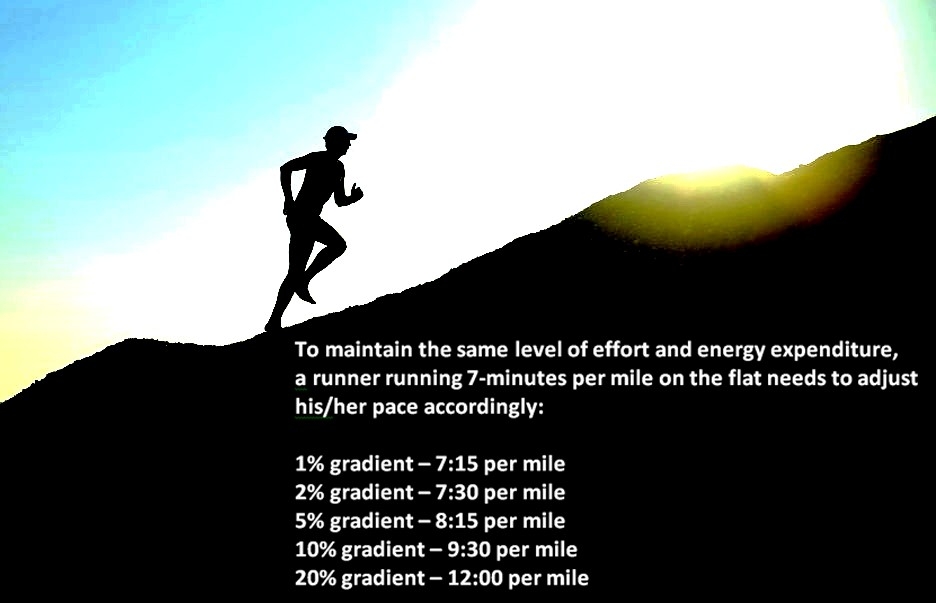You are viewing 1 of your 1 free articles. For unlimited access take a risk-free trial
The secret to successful hill-running
Runners have always had a special relationship with hills. But love them or hate them, there's one thing for sure - you can't ignore them! And the reason for that is simple – even a gentle hill has a massive impart on your energy expenditure and effort level.
Although some energy is used to generate forward propulsion, most of the energy expended during running is used to overcome the force of gravity. This becomes more apparent when you think about the running action, which involves a series of strides in which both feet are simultaneously off the ground – almost like a series of forward jumps. As you increase running speeds, there's more forward propulsion, but crucially there's also more vertical ‘lift' required in order to lengthen the stride.
Gradient and energy requirements
The energy and therefore oxygen requirements for running are approximately given by the following formula:Oxygen consumption = [0.2 x speed] + [0.9 x speed x gradient] + 3.5
NB - (oxygen consumption is measured in mls per kilo of body weight per minute, speed is in metres per minute and gradient is in % expressed as a fraction)On a flat surface, we can see that oxygen consumption rises linearly with speed because if the gradient is zero, the second part of equation is also zero and oxygen consumption is simply 0.2 x speed in metres per minute + 3.5. At 1kmh (16.8 metres per minute) the oxygen required at 13kmh (~8mph) on the flat = 0.2 x 13 x 16.8 + 3.5 = 47mls/kg/min.
Add in some gradient however and things look very different because the ‘gradient' part of the equation (the 2nd term) now kicks in, adding to the oxygen requirements. For example at 10% gradient and 13kmh, the equation now reads:
Oxygen consumption = [0.2 x 13 x 16.8] + [0.9 x 13 x 16.8 x 0.1(gradient)] + 3.5
= [43.5] + [19.5] + 3.5 = 66.5mls/kg/min
With a 10% gradient (which is not too steep), you now need 50% more oxygen to maintain the same speed!Let's suppose you're a moderately fit runner with a maximum aerobic capacity (VO2max) of 55mls/kg/min. At 13 kmh on the flat, you would be using just over 80% of your VO2max, and should be able to keep going at that pace. But come that 10% hill, you'd be exceeding your maximum capacity and after a short period of anaerobic work, would be forced to slow down or even stop completely.
Changing the pace
Charging up a hill at the same pace you fun flats will soon get you in trouble. So another useful metric is to look at how much you need to slow your pace by when ascending a hill, in order to maintain an equal energy expenditure.The figure below gives some examples for a runner who can maintain a 7-minute mile pace on the flat. Note that even for a relatively modest 10% gradient, he or she would have to slash the pace to 9 minutes 30secs per mile!

Running hills better
Coaches and scientists have long pondered best to manipulate hill pacing strategies in order to maximise the overall performance in an event. And as Rick Lovett explains in his forthcoming article in the next issue of Sports Performance Bulletin, there's more to this science than meets the eye.In particular, it turns out that correct downhill pacing is just as important as the climbing segment of a hill. The good news for those who love (or hate!) running hills is that there are a numbing of coaching strategies and drills you can deploy to improve your hill-running prowess. Combined with the right hill tactics during a race, you can learn how to turn hills to your advantage – something even Alberto Salazar had to learn!
Newsletter Sign Up
Testimonials
Dr. Alexandra Fandetti-Robin, Back & Body Chiropractic
Elspeth Cowell MSCh DpodM SRCh HCPC reg
William Hunter, Nuffield Health
Newsletter Sign Up
Coaches Testimonials
Dr. Alexandra Fandetti-Robin, Back & Body Chiropractic
Elspeth Cowell MSCh DpodM SRCh HCPC reg
William Hunter, Nuffield Health
Keep up with latest sports science research and apply it to maximize performance
Today you have the chance to join a group of athletes, and sports coaches/trainers who all have something special in common...
They use the latest research to improve performance for themselves and their clients - both athletes and sports teams - with help from global specialists in the fields of sports science, sports medicine and sports psychology.
They do this by reading Sports Performance Bulletin, an easy-to-digest but serious-minded journal dedicated to high performance sports. SPB offers a wealth of information and insight into the latest research, in an easily-accessible and understood format, along with a wealth of practical recommendations.
*includes 3 coaching manuals
Get Inspired
All the latest techniques and approaches
Sports Performance Bulletin helps dedicated endurance athletes improve their performance. Sense-checking the latest sports science research, and sourcing evidence and case studies to support findings, Sports Performance Bulletin turns proven insights into easily digestible practical advice. Supporting athletes, coaches and professionals who wish to ensure their guidance and programmes are kept right up to date and based on credible science.









